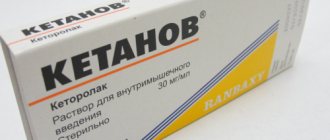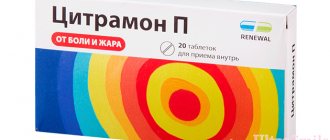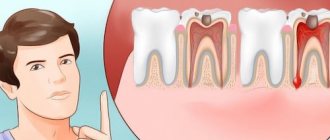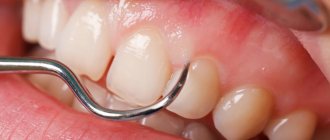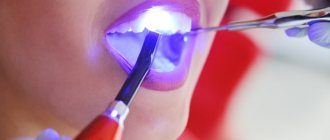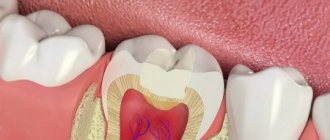The product Kalasept (liquid sterile gypsum) belongs to intracanal sterile preparations and has pronounced biological properties of hydroxide: anti-inflammatory properties, hemostatic effect, inhibition of the processes of destruction of the bone structure with simultaneous stimulation of the regenerative processes occurring there.
In 1990, the Swedish company SCANIA DENTAL experimentally established at the biochemical level that calcium hydroxide (Ca(OH)2), which is indispensable in dentistry, must be completely sterilely packaged and kept hermetically sealed when used. This allowed Ca(OH)2 not to come into contact with the surrounding air, to quickly harden and not lose its unique therapeutic properties. After many experimental and clinical studies, the Swedish company Nordiska Dental created the CALASEPT radiopaque paste with a calcium hydroxide base.
The material can be used to perform therapeutic, preventive and restorative dental procedures. At the same time, it can isolate deep carious cavities, protect and protect the pulp and dentin, performing the functions of an isolating protective cement barrier. Today, due to its osteosynthetic activity, sterile calcium hydroxide is actively used in endodontic treatment, implantology and periodontics.
Due to the good absorption of the product by dental tissue, it is ideal as the main material for temporary filling of the root canal. This procedure calcifies dentinal tubules, disinfects root canal cavities, and reduces the risk of pathogenic microorganisms penetrating into the deep layers of dentin during inflammatory and purulent processes. Temporary filling using the sterile material Kalasept eliminates possible reinfections in the root canals of the teeth and significantly reduces the incidence of various dental complications in both periodontitis and pulpitis.
A few words about the manufacturer
Back in 1990, Scania Dental proved that calcium hydroxide used in dentistry must be sterile and hermetically packaged. Only this approach to storage eliminates contact of the substance with the external environment, in which it quickly hardens and loses its properties. Later, based on this information, the Swedish company Nordiska Dental developed Calasept. Today this paste is widely used in endodontics, periodontics and dental implantation.
Equipment, release form and price
Kalasept is available in a standard kit, which consists of:
- From syringe cartridges with paste (2.5 g) – 5 pcs;
- Sterile needles – 30 pcs;
- Flexi-tip cannulas – 30 pcs.
The cost of the entire set is 1,850 rubles, one cartridge costs 420 rubles. The drug has analogues:
- Metapex, included 2 syringes (2.2 g) – 1,010 rubles;
- Calsept, included 2 syringes (2.5 ml) – 580 rubles.
Kalasept is produced by the Swedish pharmacological company Nordiska Dental.
Composition and key characteristics of the drug
As mentioned above, the drug is based on calcium hydroxide - this substance activates regenerative functions and stops the spread of inflammation. "Kalasept" is used to disinfect canals and ensure their protection from the spread of pathogenic microflora. The composition contains the following components:
- calcium hydroxide,
- calcium chloride,
- sodium bicarbonate and sodium chloride.
The product is injected into the canals directly from the syringe. Therefore, one kit includes 5 hermetically sealed syringes filled with the substance, as well as 30 needles.
“I had my canals filled with this paste when I was treating pulpitis. Everything went fine. They put it in for about two weeks, I don’t remember exactly. There were no strange reactions from the tooth. Adverse reactions too. The doctor said that this is a good, proven remedy; after all, Sweden is a sign of quality.”
Antonina_V., from correspondence on the forum www.32top.ru
The drug is produced in hermetically sealed syringes.
Using this composition, canals are filled with pulpitis and used to protect the internal structures of the tooth from external aggressive factors. It is also indicated in the treatment of advanced caries, injuries and root fractures, to eliminate inflammatory processes in the pulp and provide its antibacterial treatment. As for how long you can leave “Kalasept” inside the tooth, the instructions on this matter indicate a period of up to six months.
special instructions
For the safe and effective use of the material, certain conditions for its use and storage must be observed:
- The drug must be stored tightly closed in an airtight container. Otherwise, calcium hydroxide (the main component of the composition) in contact with air is transformed into calcium carbonate, in other words, into ordinary chalk, after which it will lose all its beneficial properties.
- The material should not be frozen; low temperatures also contribute to the loss of the basic properties of the composition.
- Place the drug for storage in places with low humidity and air temperature in the range from +4 to +24 degrees.
- Do not use the paste after the expiration date, which is 3 years, and 2 years after the package was opened.
- Since the composition contains caustic substances, it is necessary to avoid contact of the composition with the skin and mucous membranes, as well as the esophagus and respiratory organs. If the material comes into contact with the skin or eyes, these areas must be immediately rinsed with plenty of clean running water.
- If the composition is swallowed (even in negligible quantities), it is necessary to give the victim milk, at least 0.5 liters at a time, and then take him to a medical facility to the appropriate specialist.
Following these recommendations will allow you to use the antiseptic composition effectively and safely.
Properties of Kalasept paste
The drug is a liquid sterile substance with a pronounced hemostatic, antibacterial and anti-inflammatory effect. The product stops destructive processes and activates regeneration at the cellular level. By reacting with oxygen, the active substance quickly hardens and provides reliable protection of the internal structures of the tooth, while preventing further destruction of dentin.
Experts in the field of endodontics highlight the following main properties of Kalasept paste:
- antibacterial effect – protection against penetration of pathogenic microorganisms into dentin. A few minutes after application are enough to destroy all pathogenic microorganisms,
- stimulation of regenerative functions – the product promotes the appearance of secondary dentin and tubules,
- restoration - the composition fills and effectively eliminates cracks and damage.
The drug has an antibacterial and anti-inflammatory effect.
With this drug, specialists successfully treat even advanced forms of carious processes. The composition itself is moderately viscous, uniform in consistency, and does not cause irritation to periodontal tissue.
Clinical indications and contraindications
The composition is completely absorbed by living tissues. It is used in the following clinical cases:
- cracks and fractures of the roots - the paste makes it possible to completely restore tissue if their integrity is violated, preserves the viability of the nerve and ensures the formation of replacement dentin. First, the doctor removes all damaged tissue of the root pulp, after which he carries out a special treatment of the canals and installs gutta-percha with preliminary filling with the drug “Kalasept”. If the pulp is too damaged, the doctor removes it completely, fills the canals with a product and installs a gutta-percha pin,
- deep caries and pulpitis - as part of therapy, the specialist makes applications directly into the affected cavities, which ensures the protection of dental tissues and the complete destruction of pathogenic microflora. 1-4 weeks after the procedure, complete sterility will be achieved due to the formation of secondary dentin,
- opened pulp - the paste is applied in layers to the affected area of the neurovascular bundle, thereby providing reliable protection against harmful microorganisms. The product also stimulates the process of regeneration of damaged tissues,
- affected canals - the paste is applied before permanent filling. The product ensures disinfection and calcification of dentinal tubules, and also seals the root apex,
- periodontitis – preparation for treatment,
- complications after tooth injuries (luxations and subluxations) - the product promotes the healing of damaged tissues.
The product is used for deep caries and pulpitis
. As mentioned above, the “Kalasept” product is actively used in the treatment of various forms of caries, pulpitis and periodontitis, fractures and dislocations of the root system, and peri-implantitis. The drug does not provoke complications and is suitable for repeated use, that is, it can be applied until the inflammatory process is completely eliminated. However, in rare cases, the active components of the composition may cause side effects in the form of allergic reactions. Some patients experience individual intolerance to the active ingredients of the drug1.
Calsept - instructions for use
Before filling the canal, pulp and softened, infected dentin are removed from the root canal of the tooth.
The canal is carefully treated mechanically and with medications.
A cannula can be inserted almost completely into a wide straight channel and a portion of Calcept paste (with iodoform) can be squeezed out, and then condensed using the usual method.
In curved canals, Calcept paste (with iodoform) is applied to the mouth of the canal and tightly condensed inside with endodontic instruments or sterile turunda.
The better the paste is condensed, the better the radiopacity of the material on the radiograph. It is enough to fill the canal up to the top, and in poorly passable canals the entire passable part, with a developed growth zone, 1-2 mm short of reaching the top of the canal. When removing the material beyond the root tip, no problems arise due to the high alkalinity and complete immunoindifference of the material. Next, the cavity is closed with cement.
Application of Calasept
- Protection of dentin (tooth tissue) and pulp. The drug is used as a gasket between the tooth cavity and its soft tissue inside the tooth (pulp). Subsequently, the formation of complete dentin is formed.
- Treatment of caries, when the affected areas of the tooth are cleaned and Kalasept is applied to them, giving the tooth its previous shape.
- Closing perforations, cracks and fractures in teeth.
- Restoration of damaged pulp. The product applied to a damaged tooth promotes the appearance of secondary dentin, which isolates the pulp.
- Destruction of 100% of microorganisms in the inflamed pulp, i.e. has a bactericidal effect.
- Preparing the damaged tooth for the following treatment measures.
This is interesting: Root canal obturation - types, causes, treatment
First of all, Kalasept paste is used as a corrosive material to fill and restore tooth roots. This is the process of restoring the function and shape of a tooth. In this case, the dental canal is sterilized, eliminating the possibility of infection from infection in the deep layers of the dental roots. Purulent inflammations are eliminated.
Calacept in syringes
Before using the drug Kalasept, take a syringe cartridge and pierce its protective film with a needle. After this, the cap is removed from it and bent to the shape of the tooth canal. Then the paste is fed into the tooth cavity from a syringe.
Cannulas from Kalasept are included in the kit without fail.
To save the remainder of the product, you need to put a piece of cotton wool moistened with distilled water into the needle sheath and close the top of the syringe with a cap. The material should be stored at room temperature, do not freeze!
It is suitable for use within two years after manufacture. It is recommended to use Kalasept carefully, to protect your eyes and skin of your hands when using the drug, as this material is caustic. In case of contact with skin or mucous membranes, immediately rinse these areas with water.
Calasept cannulas are inferior in convenience to Metapex cannulas; you can use them at your discretion.
Treatment with Kalasept
Tooth decay comes from caries, which develops due to the presence of microorganisms in the oral cavity.
- The dentist numbs the soft tissues around the tooth.
- Performs preparation, thereby cleansing the tooth of darkened enamel, tartar and caries. Completely cleans the dental cavity.
- The doctor examines the condition of the pulp. When it becomes inflamed, the dentist removes it from the tooth and performs depulpation (removal of the nerve).
- Antimicrobial pads are inserted into the dental canal to completely disinfect the dental tissue.
- Filling is the final stage of treatment.
Treatment with Kalasept. Result after 4 months.
The tooth is polished and ground
Fillings are divided into two types: temporary and permanent. During tooth treatment, it is necessary to determine how the dental nerve will behave under the filling. Perhaps it is already affected by caries and the patient will feel pain all the time. To do this, the tooth is cleaned and covered with a temporary filling. If the tooth does not bother you for two weeks, the patient is given a permanent filling.
When it is necessary to remove the inflamed nerve from the dental cavity, arsenic is placed in the tooth and also closed with a temporary filling.
Result after Kalasept. After 2 months
Instructions - description of the canal filling technique
The drug should be used strictly according to the instructions. First, the crown and root canals are cleared of diseased and necrotic tissue. After this, the doctor carries out a thorough antiseptic treatment and then proceeds to applying the composition. A special syringe is used to administer the substance. First, the specialist carefully pierces the protective membrane with a needle and removes the cap, after which he bends the cannula to the shape of the channel to be filled.
The product is administered in small portions, and after each portion it is compacted with adsorbents. For this purpose, special endodontic instruments, pins and cotton balls are used. Thus, the technique for performing the procedure is as follows:
- administration of anesthesia,
- preparation of the tooth and its cleaning from infected and destroyed tissues,
- thorough cleaning of the cavity and channels,
- partial or complete depulpation due to inflammation of the neurovascular bundle,
- introduction of medicinal paste into the canals,
- installation of a seal.
The photo shows a treatment plan for pulpitis.
In this case, a temporary filling can be performed first - this is necessary to check the condition of the nerve and ensure that signs of the inflammatory process are completely eliminated. If the pulp is too damaged, it will be removed and a permanent filling will be done a couple of weeks later.
Useful information: what types of fillings are there?
Dental fillings are made from different materials:
- Cement fillings are the most inexpensive and accessible to the entire population. They differ in color from tooth enamel and therefore stand out against the background of the tooth. Such fillings also destroy teeth when they touch in the bite. Cement fillings are most often used in pediatric dentistry on baby teeth.
- Metal (amalgam) fillings are made from an alloy of copper and silver + mercury. They are very durable, but noticeable against the background of the tooth. They are placed on the indigenous ones, i.e. chewing teeth. The alloy is slightly toxic. Currently not actually used!
- Composite fillings are made from a mixture of resin and finely ground glass powder. Previously, these fillings were not strong, but now they have learned to make them solid. The composite filling is placed gradually, in layers. Each layer interacts with ultraviolet light for 30-40 seconds. This material matches the color of tooth enamel, as it has a huge palette. Typically, this paste is used to restore the front teeth - restoration, but the material is also indicated for restoring defects in other groups of teeth.
- Inlays are most often made of ceramic; they are similar in color to tooth enamel. The inlay is made within a week in the laboratory. This inlay blends in with the tooth and is invisible. Previously, metal inlays were used to restore tooth defects (IROPZ index > 0.55).
Pastes containing calcium hydroxide are a reliable material that is used to correct and protect dental damage. Used as pads to treat inflammatory processes in the pulp or periapical tissues. Not used as materials for permanent filling of teeth!
Precautionary measures
The paste must be stored under certain conditions described in the instructions. It should not be frozen to avoid loss of therapeutic properties. The specialist must also carefully ensure that the composition does not come into contact with the skin or mucous membranes of the eyes. It is important to ensure that the patient does not accidentally swallow the material so that it does not enter the respiratory tract. In case of accidental ingestion, drink large quantities of water or milk. In case of contact with skin or eyes, rinse thoroughly. In this case, the drug is allowed for use during pregnancy, regardless of the period.
Reviews
Many dentists use such a unique drug as Calasept in their work.
The tool increases the efficiency of specialists. You can leave comments and share your experience with this drug.
If you find an error, please select a piece of text and press Ctrl+Enter.
Tags filling fillings
Did you like the article? stay tuned
Previous article
Ionositol – compomer material for extending the service life of fillings
Next article
The relevance of the use of separation rings for bite correction in orthodontics
Drugs with similar effects
As an analogue of "Kalasept" we can highlight the drug "Metapex". It also contains calcium hydroxide, and the auxiliary substance is iodoform. The area of application is the same - filling canals. The product has a pronounced antibacterial effect. One kit includes a syringe weighing 83 g, as well as 20 disposable tips for quick and convenient application of the substance.
Another drug with a similar effect is Calcept. Pasty mass based on calcium hydroxide with or without iodoform. The latter provides enhanced antiseptic action. The kit includes 2 syringes of 2.5 ml, as well as 20 disposable cannulas.
"Calcept" - has a similar composition
Another popular means for filling canals is Silapex. It contains, along with calcium hydroxide, zinc oxide and titanium dioxide. The drug stimulates the formation of hard tissues and is well accepted by the body. Only it is not sold in finished form - it requires independent preparation by mixing the ingredients.
1According to information at the office. website of the manufacturer: nordiskadental.se.
Storage conditions
- Do not leave syringes open.
- Store in a dry place, protected from light, at a temperature from +4°C to +24°C.
- Shelf life – 3 years. The expiration date is indicated on the packaging.
Transportation conditions: all types of covered, dry, clean and odor-free vehicles in accordance with the requirements of GOST 17768 and the rules for the transportation of goods applicable to this type of transport.
Warranty obligations: the manufacturer guarantees the quality of the medical product until its expiration date, subject to the conditions of use, transportation and storage.
Disposal: Disposal of the material must be carried out in accordance with the general rules for organizing a system for collecting, temporary storage and transportation of waste to health care facilities for class A waste (non-hazardous) according to SanPiN 2.1.7.2790.
